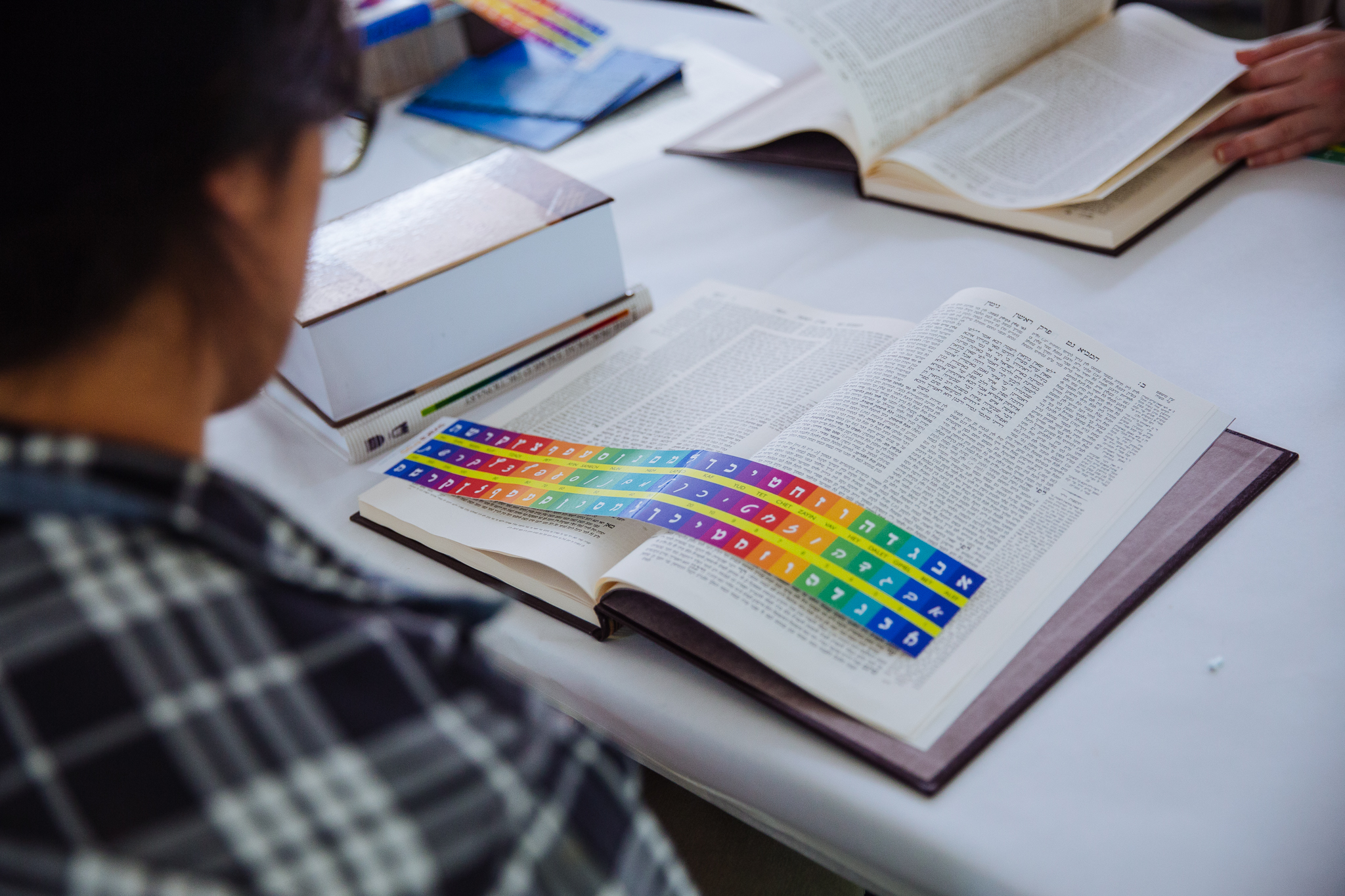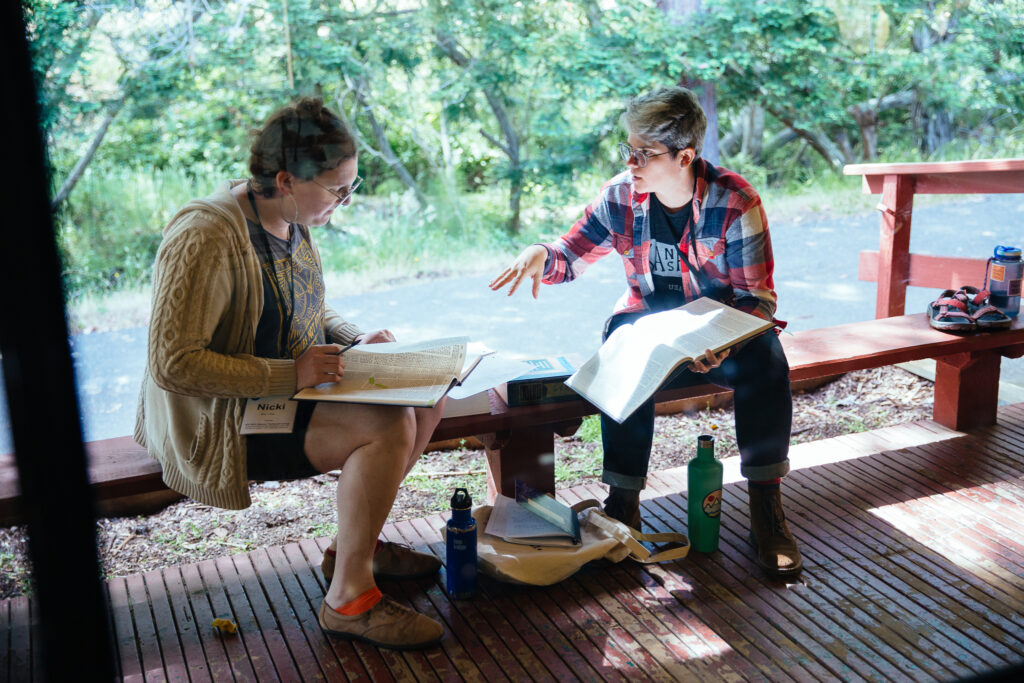
This aggadic (narrative) sugya showcases the Rabbinic project in action as the Tannaim battle against one another (and against heaven itself!) to claim the authority to shape our tradition. We’ve divided this lengthy sugya into eleven chevruta sessions, but (as always!) y’all are encouraged to learn at the pace that feels best to you. You can learn the core story in sections 1-7 or keep going through section 11 to explore the profound and tragic aftermath of this formative myth.
Prep the Sugya
Just like in the bet midrash, the SVARA method for DIY Learning starts with prepping the text in chevruta. In this step, you’ll move through a section of the sugya word by word, identifying each word’s root and core meaning, and creating an inside translation. Use the Hint Sheet to help break down any tricky words and the Kra Sheet to get context for any scriptural quotations you encounter. If you don’t have a bound masechet, you can download a digital daf to learn from.
This sugya begins with the last line of the amud on Bava Metzia 59a. We recommend breaking the sugya down into smaller chunks as you cycle through the four steps of the SVARA method one section at a time. We suggest learning this text in the following chunks:
1) תנן התם חתכו … תנור של עכנאי
2) מאי עכנאי אמר רב יהודה … ולא קיבלו הימנו
3) אמר להם … ראיה מן החרוב
4) חזר ואמר להם … כותלי בית המדרש ליפול
5) גער בהם רבי יהושע … ועדיין מטין ועומדין
6) חזר ואמר להם … לא בשמים היא
7) מאי לא בשמים היא … נצחוני בני נצחוני בני
8) אמרו אותו היום … כל העולם כולו
9) מה עשה ר׳׳ע … שחבירים בדילים ממך
10) אף הוא קרע … עיניו ר׳׳א נשרף
11) ואף ר׳׳ג היה בא בספינה … נח הים מזעפו
Create an Outside Translation
After you’ve prepped a chunk of text, going word-by-word, in chevruta, it’s time to move from your inside translation to an outside translation. Make your best guess by identifying the verbs, subjects, and objects, inserting punctuation, and getting a feel for the back-and-forth structure of the text. In a SVARA Bet Midrash it would now be time for Shiur—time to unpack the text with a teacher and all your bet midrash comrades. For DIY learning, listen to these recordings to compare your translation with a SVARA teacher’s.
Below are recordings of a teacher reading and translating each section of text.
1) תנן התם חתכו חוליות ונתן חול בין חוליא לחוליא ר׳׳א מטהר וחכמים מטמאין וזה הוא תנור של עכנאי
Reading
Translating
2) מאי עכנאי אמר רב יהודה אמר שמואל שהקיפו דברים כעכנא זו וטמאוהו תנא באותו היום השיב רבי אליעזר כל תשובות שבעולם ולא קיבלו הימנו
Reading
Translating
3) אמר להם אם הלכה כמותי חרוב זה יוכיח נעקר חרוב ממקומו מאה אמה ואמרי לה ארבע מאות אמה אמרו לו אין מביאין ראיה מן החרוב
Reading
Translating
4) חזר ואמר להם אם הלכה כמותי אמת המים יוכיחו חזרו אמת המים לאחוריהם אמרו לו אין מביאין ראיה מאמת המים חזר ואמר להם אם הלכה כמותי כותלי בית המדרש יוכיחו הטו כותלי בית המדרש ליפול
Reading
Translating
5) גער בהם רבי יהושע אמר להם אם תלמידי חכמים מנצחים זה את זה בהלכה אתם מה טיבכם לא נפלו מפני כבודו של רבי יהושע ולא זקפו מפני כבודו של ר׳׳א ועדיין מטין ועומדין
Reading
Translating
6) חזר ואמר להם אם הלכה כמותי מן השמים יוכיחו יצאתה בת קול ואמרה מה לכם אצל ר׳׳א שהלכה כמותו בכ׳׳מ עמד רבי יהושע על רגליו ואמר לא בשמים היא
Reading
Translating
7) מאי לא בשמים היא אמר רבי ירמיה שכבר נתנה תורה מהר סיני אין אנו משגיחין בבת קול שכבר כתבת בהר סיני בתורה אחרי רבים להטות אשכחיה רבי נתן לאליהו א׳׳ל מאי עביד קוב׳׳ה בההיא שעתא א׳׳ל קא חייך ואמר נצחוני בני נצחוני בני
Reading
Translating
8) אמרו אותו היום הביאו כל טהרות שטיהר ר׳׳א ושרפום באש ונמנו עליו וברכוהו ואמרו מי ילך ויודיעו אמר להם ר׳׳ע אני אלך שמא ילך אדם שאינו הגון ויודיעו ונמצא מחריב את כל העולם כולו
Reading
Translating
9) מה עשה ר׳׳ע לבש שחורים ונתעטף שחורים וישב לפניו ברחוק ארבע אמות אמר לו ר׳׳א עקיבא מה יום מיומים אמר לו רבי כמדומה לי שחבירים בדילים ממך
Reading
Translating
10) אף הוא קרע בגדיו וחלץ מנעליו ונשמט וישב על גבי קרקע זלגו עיניו דמעות לקה העולם שליש בזיתים ושליש בחטים ושליש בשעורים ויש אומרים אף בצק שבידי אשה טפח תנא אך גדול היה באותו היום שבכל מקום שנתן בו עיניו ר׳׳א נשרף
Reading
Translating
11) ואף ר׳׳ג היה בא בספינה עמד עליו נחשול לטבעו אמר כמדומה לי שאין זה אלא בשביל ר׳׳א בן הורקנוס עמד על רגליו ואמר רבונו של עולם גלוי וידוע לפניך שלא לכבודי עשיתי ולא לכבוד בית אבא עשיתי אלא לכבודך שלא ירבו מחלוקות בישראל נח הים מזעפו
Reading
Translating
Go Deeper
Can’t get enough of this sugya? Neither can we! Our DIY Chevruta resources now include a range of SVARA commentary on our all-time favorite texts. Check out the articles below by our faculty and fairies in Hot Off the Shtender and the discussion of this sugya by Rosh Yeshiva Benay Lappe and Dan Libenson on The Oral Talmud.
Did this sugya inspire you to make art, music, poetry, pottery, or another type of creative expression? We’d love to display your commentary in whatever form it takes in the SVARA gallery. (You can check out what others have made too.)
Want to dig in even further? Let’s connect in fairy hours!

